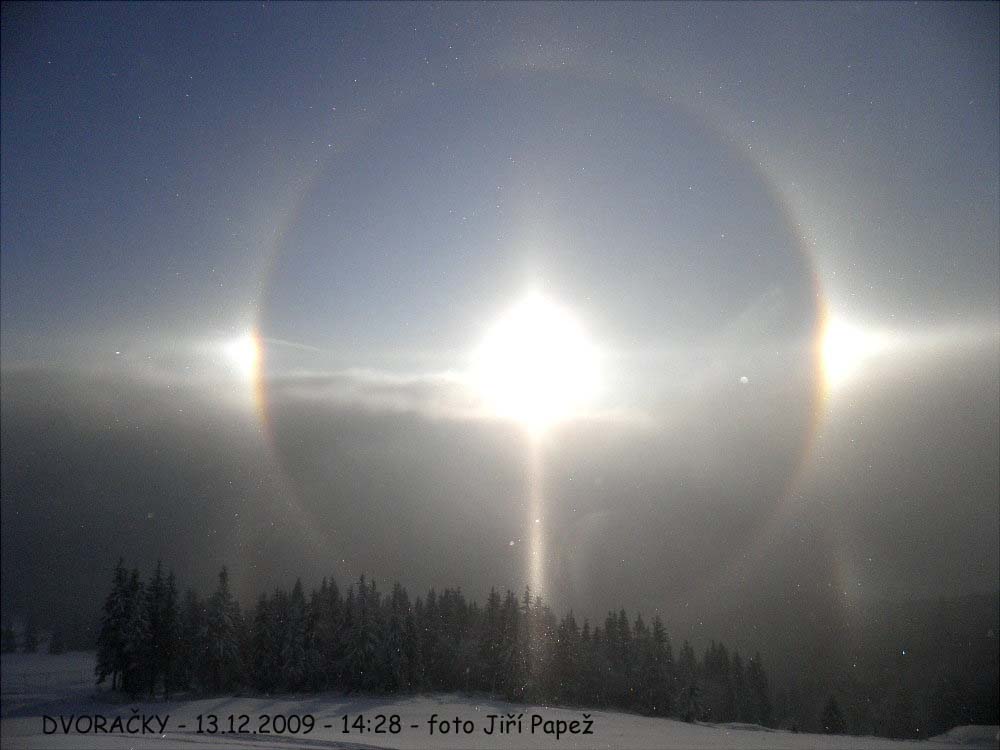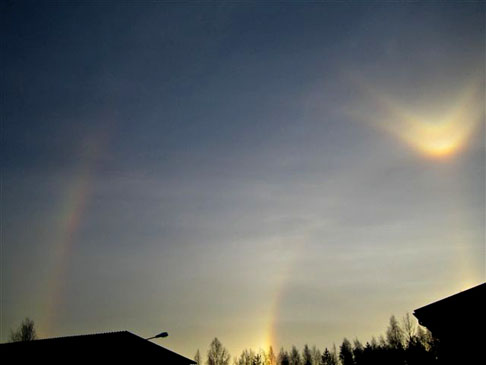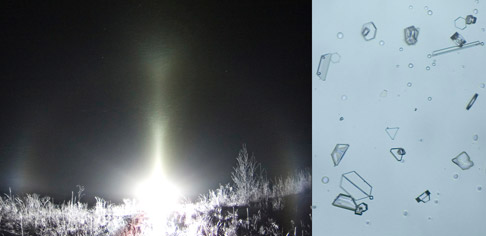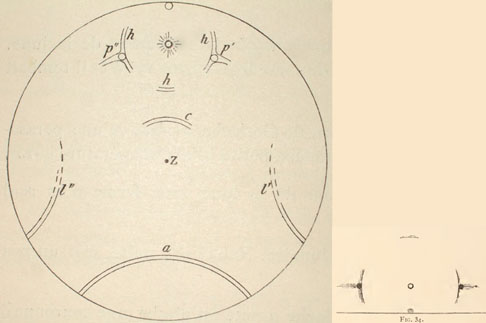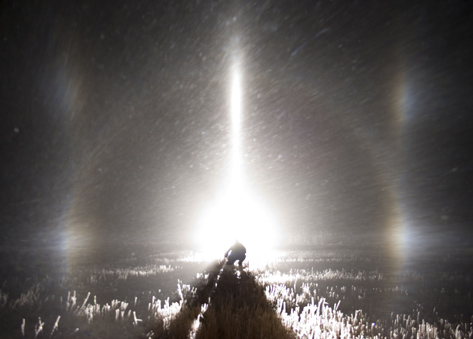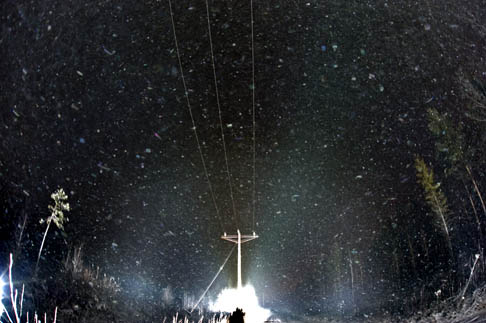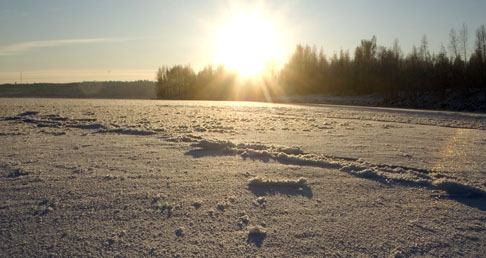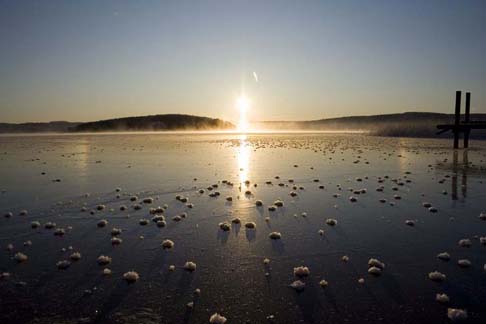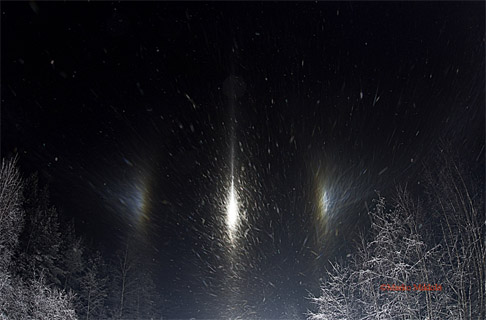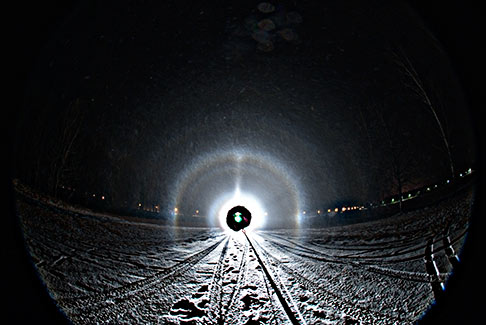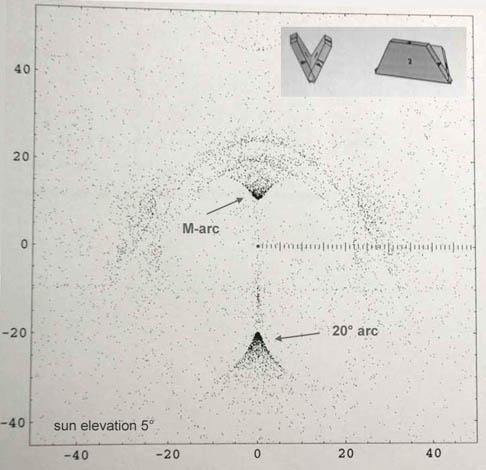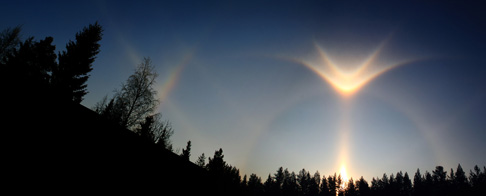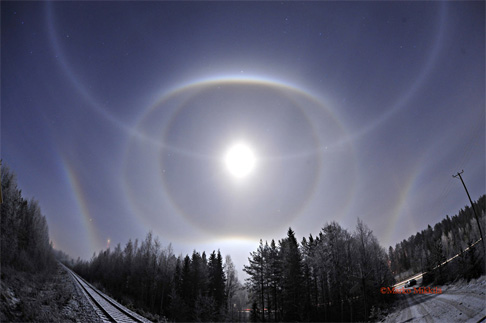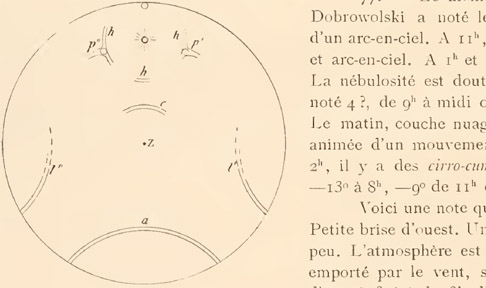2009. december 30., szerda
Halo Season in the Czech Republic
The halo season has started in the Czech Republic, too. The above image was shot by Jiri Papez on 13 December in Dvoracky ski center. Nearby on Lysa hora the display was captured by the Hydronet.cz camera ( 1 ).
2009. december 27., vasárnap
Sunvex Parry
This display was photographed on 4th December by Liisa Eronen in Kulho, Kontiolahti, Finland. The temperature was around -4°C. Nearest ski center is located about 10 km away, so most likely this was caused by snow guns.
2009. december 24., csütörtök
Moilanen arc display crystal sampled
On the 14th November Mika Aho, Ágnes Kiricsi and I were hunting halos around Himos ski resort. Diamond dust was all over the place but it was not good, offering at best less than mediocre displays. At one stage when Moilanen arc was visible, I sampled crystals while Mika and Ágnes photographed the halos. The display was pretty stable during the time the petri dish was out, so the crystal photos should be representative. See more photos of the display ( 1 ) and crystals ( 2 ). An earlier stage without Moilanen arc ( 3 ) was also crystal sampled ( 4 ).
Marko Riikonen
Marko Riikonen
2009. december 21., hétfő
Arctowski's account of the August 20, 1898 display
Below is the promised translation of the Arctowski's famous observation in the Antarctic. Thanks for Frank Le Blancq for translating. In hard brackets are some clarifications by Frank. Translation of the whole double page of the book ( 1 ) where the observation appears is also available ( 2 ).
"77 – The same day from 8 to 10am, Dobrowolski noted the parhelia, accompanied at 10am by a rainbow. At 11am he noted a halo. At midday : halo and rainbow. At 1pm and at 2pm : double halo. There was doubt about the cloud cover; thus at 8am we noted 4?, from 9am to midday 0?, at 1pm : 1?. Horizon misty. The morning a thin layer of low cloud, cirriform, moving quickly. In the afternoon at 1pm and 2pm the were some cirro-cumulus on the horizon. Temperature –13° at 8am, -9° from 11am to 2pm.
Here is a note I took at 1130am : Light westerly breeze. A little blowing snow but not much. The atmosphere was full of crystals, which, carried by the wind, scintillated [sparkled] in the air giving the impression of an infinity of gold and silver threads. We found ourselves in cirrus ; we saw it better towards the horizon, where there was a clearer aspect of mist. The halo phenomenon showed itself in a more complete form than usual. In figure 33 the outer circle represents the horizon, s the sun, z the zenith, h, h, h the fragments of the halo wth parhelia, p’, p’’ the fragments of the horizontal circle, a a rainbow as opposed to the halo, l’ and l’’ two fragments of the barely visible great arcs and finally c the arc of a circumzenithal circle. I measured the diametre of the halo h : 53° (radius 26° ; it is not therefore the normal halo). Distance from c to the zenith : 28 or 29°. The rainbow a covered 67° of the horizon and the base of the arcs l’ and l’’ we found about 30° from the extremities of arc a. The parhelia were clearly marked [visible], the same as the image of the sun on the horizon which was very bright (figure 34). There was no cross nor aureole. The fragments of the horizontal circle were like the fading lateral trails from the parhelia. The fragment of the zenithal circle (reddish, becoming white on the inside) were very interesting for the observer. We saw effectively that there were clouds of crystals [i.e many crystals] blown by the wind. It became apparent a short distance aloft of the BELGICA, because we could clearly see the gusts of crystals which passed it. Moreover, against the ships crow’s nest [lookout point up the mast] the wind produced a swirl and there it formed a little whirlwind which had a coloured appearance and which, like the circumzenithal circle, produced a bright trail. So, these phenomena far from being moved away from the observer, projected themselves as if they were a long way in the sky, while in reality they were very close to us. At about 2.30pm there were again traces of the morning parhelia and, as the atmosphere contained fewer crystals, the solar halo was very beautiful due to its variety of colours : the red inside, then orange, then yellow, the green and blue were visible. However, the coloured band was very tight [close together]."
"77 – The same day from 8 to 10am, Dobrowolski noted the parhelia, accompanied at 10am by a rainbow. At 11am he noted a halo. At midday : halo and rainbow. At 1pm and at 2pm : double halo. There was doubt about the cloud cover; thus at 8am we noted 4?, from 9am to midday 0?, at 1pm : 1?. Horizon misty. The morning a thin layer of low cloud, cirriform, moving quickly. In the afternoon at 1pm and 2pm the were some cirro-cumulus on the horizon. Temperature –13° at 8am, -9° from 11am to 2pm.
Here is a note I took at 1130am : Light westerly breeze. A little blowing snow but not much. The atmosphere was full of crystals, which, carried by the wind, scintillated [sparkled] in the air giving the impression of an infinity of gold and silver threads. We found ourselves in cirrus ; we saw it better towards the horizon, where there was a clearer aspect of mist. The halo phenomenon showed itself in a more complete form than usual. In figure 33 the outer circle represents the horizon, s the sun, z the zenith, h, h, h the fragments of the halo wth parhelia, p’, p’’ the fragments of the horizontal circle, a a rainbow as opposed to the halo, l’ and l’’ two fragments of the barely visible great arcs and finally c the arc of a circumzenithal circle. I measured the diametre of the halo h : 53° (radius 26° ; it is not therefore the normal halo). Distance from c to the zenith : 28 or 29°. The rainbow a covered 67° of the horizon and the base of the arcs l’ and l’’ we found about 30° from the extremities of arc a. The parhelia were clearly marked [visible], the same as the image of the sun on the horizon which was very bright (figure 34). There was no cross nor aureole. The fragments of the horizontal circle were like the fading lateral trails from the parhelia. The fragment of the zenithal circle (reddish, becoming white on the inside) were very interesting for the observer. We saw effectively that there were clouds of crystals [i.e many crystals] blown by the wind. It became apparent a short distance aloft of the BELGICA, because we could clearly see the gusts of crystals which passed it. Moreover, against the ships crow’s nest [lookout point up the mast] the wind produced a swirl and there it formed a little whirlwind which had a coloured appearance and which, like the circumzenithal circle, produced a bright trail. So, these phenomena far from being moved away from the observer, projected themselves as if they were a long way in the sky, while in reality they were very close to us. At about 2.30pm there were again traces of the morning parhelia and, as the atmosphere contained fewer crystals, the solar halo was very beautiful due to its variety of colours : the red inside, then orange, then yellow, the green and blue were visible. However, the coloured band was very tight [close together]."
2009. december 20., vasárnap
Subparhelia at Himos
Diamond dust started falling around Himos, Finland on 14 December, and kept on for 4 consecutive days. This display with subparhelia was shot on the first day. A full parhelic circle was also observed, and for a short time, part of the subparhelic circle was visible, too ( 1 ). Marko Riikonen sampled the crystals during the display ( 2 ).
Ágnes Kiricsi
2009. december 18., péntek
Liljequist parhelia in spotlight beam
One would think that such a demanding halo as Liljequist parhelia would need the best possible swarm to be seen. While that may be true in halo displays from natural light sources, with spotlight it is a different story. Here Liljequist parhelia - the two diffuse light areas both sides of the observers shadow - are visible despite the apparently crappy crystals that are filling the air.
Also visible are vague upwards curving extesions from Liljequist parhelia, which might have formed a complete half circle around subanthelic point if there was no cutting shadow. These are signs of the diffuse subanthelic halo that was photographed last winter in Rovaniemi ( 1 ). See also the lamp side of the display ( 2 ). The photo was taken by Marko Mikkilä in Sotkamo on 14th December. Click on the image to see a simulation.
Also visible are vague upwards curving extesions from Liljequist parhelia, which might have formed a complete half circle around subanthelic point if there was no cutting shadow. These are signs of the diffuse subanthelic halo that was photographed last winter in Rovaniemi ( 1 ). See also the lamp side of the display ( 2 ). The photo was taken by Marko Mikkilä in Sotkamo on 14th December. Click on the image to see a simulation.
One sided 22° halo on hardened snow
Last winter I noticed one sided 22° halo on ice surface ( 1 ). This winter there has been a couple of more cases with varying degree of one-sidedness. The displays seem to be a rule on even surfaces, either on plain ice or snow that wind has swept hard. The one above was seen today on lake Näsijärvi ice. It was visible on a patch of hardened snow. No matter where I moved, the asymmetry stuck.
Marko Riikonen
Marko Riikonen
2009. december 17., csütörtök
Subparhelia on ice from fallen crystals
Last Tuesday we were hunting diamond dust halos with Ágnes Kiricsi at Himos ski resort. Driving around took us to lake Päijänne, which had just started freezing. The ice was full of ice ferns, but one spot was quite clean and there subparhelia were seen. The ice surface was covered with fine powder that was wiped away from slightest disturbance. The powder was crystals that had fallen from the sky and it made the halo. Earlier we have seen examples of ice surface halos that were made of crystals grown from the lake ice ( 1 - 2 ). The image above was taken by Ágnes, see also two more of her images ( 3 - 4 ) and some of mine ( 5 ).
Marko Riikonen
Marko Riikonen
2009. december 16., szerda
Low lamp subparhelia
With the great lunar halo display from the beginning of the month still fresh in memory, Marko Mikkilä drove again to Sotkamo last monday. This time the catch was less spectacular, but something was nevertheless seen in the spotlight beam. Mikkilä managed place the lamp to a record negative angle of about -30° and photographed subsun and subparhelia as shown above. Click on the image to see more photos and also two videos.
2009. december 15., kedd
Odd Radius Halos in Diamond Dust
Spotlight beam revealed a bunch of pyramidal crystal halos on 14th December 2009 at Janakkala, Finland. I drove to Kalpalinna ski resort, where snow guns were turned on. Immediately after walking into the spotlight beam I noticed a halo well inside the 22° ring. Initially I thought that surely this is a slice of the Minnaert cigar ( 1 ), but the ring just stayed there and the crystal swarm seemed homogeneous, so I concluded that this is the 9° halo.
At the camera's LCD display the 18°/20° (?) and 35° halos could easily be seen. After first seeing them in the photo I thought I was able to see them visually too, but that was not certain. I did mess up the crystal sample, since the most-likely-pyramidal-crystals are distorted and round - the gear was still too warm during the sampling. On the other hand, if I would have waited longer, there would not be any signs of pyramids in crystal samples, since the pyramidal phase was gone in less than 10 minutes and did not reoccur during the rest of the night.
By clicking the image above the gallery opens.
At the camera's LCD display the 18°/20° (?) and 35° halos could easily be seen. After first seeing them in the photo I thought I was able to see them visually too, but that was not certain. I did mess up the crystal sample, since the most-likely-pyramidal-crystals are distorted and round - the gear was still too warm during the sampling. On the other hand, if I would have waited longer, there would not be any signs of pyramids in crystal samples, since the pyramidal phase was gone in less than 10 minutes and did not reoccur during the rest of the night.
By clicking the image above the gallery opens.
2009. december 8., kedd
When you see Moilanen arc - look below the sun!
Several of us have been talking about a possible explanation for M-arcs. The responsible crystals are twinned trapezoidal plates that have what might be called restricted Lowitz orientations. The crystals perform rotational oscillations about a horizontal axis, with the equilibrium orientation having the vee opening directly upward, as in the left hand crystal.
All of us are more or less skeptical about this explanation, but we think it deserves testing. The model predicts a strong lower 20° arc. We are asking that, if you are lucky enough to see an M-arc, then please put yourself in an elevated position and look for the lower 20° arc. There are other observing suggestions as well, but I think I will leave them for the blog.
(Walt Tape)
All of us are more or less skeptical about this explanation, but we think it deserves testing. The model predicts a strong lower 20° arc. We are asking that, if you are lucky enough to see an M-arc, then please put yourself in an elevated position and look for the lower 20° arc. There are other observing suggestions as well, but I think I will leave them for the blog.
(Walt Tape)
2009. december 7., hétfő
Bright sunvex Parry arc
Sometimes halo display actually comes to your door step. On October 14th Toivo Säkkinen got out of his house in Kuusamo to feed the birds. Instead, he decided to photograph the halos first. This must be one of the earliest diamond dusts in Finland.
2009. december 5., szombat
Lunar halo complex in Sotkamo, Finland
In the morning of 3rd Decemeber Marko Mikkilä packed his halo gear and drove 200 kilometers to Sotkamo, where snow guns were running at the local ski resort. Once he arrived, there was fog, but it was mainly water fog and only occasional poor halos were seen.
However, when darkness fell, the water fog cleared off and diamond dust started kicking in as the air got colder. In the beginning the moon showed no good halos but spotlight gave a reasonable display ( 1 ). Later also the moon halos catched on, as is seen above. Click on the image for more photos.
Simulation of the display ( 2 ) needed slightly flattened columns to get the subhelic arc intensity right. With any other crystal shapes, the part opposite to the moon where this halo is tangent to Tricker arc, was not visible. Intuitively those flattened crystals would take Parry orientation, so it looks like again we are not really understading it. Same effect was also present in the great Himos display last winter ( 3 ).
After midnight Mikkilä headed home because the high clouds in the background were becoming too disturbing. All together the halo hunting trip took 600-700 km of driving. Looking at the results it was definitely worth it. See also the photos by Jari Luomanen from the same night at the Sappee ski resort, and be sure to read his insightful description of the diamond dust formation on the right ( 4 ).
However, when darkness fell, the water fog cleared off and diamond dust started kicking in as the air got colder. In the beginning the moon showed no good halos but spotlight gave a reasonable display ( 1 ). Later also the moon halos catched on, as is seen above. Click on the image for more photos.
Simulation of the display ( 2 ) needed slightly flattened columns to get the subhelic arc intensity right. With any other crystal shapes, the part opposite to the moon where this halo is tangent to Tricker arc, was not visible. Intuitively those flattened crystals would take Parry orientation, so it looks like again we are not really understading it. Same effect was also present in the great Himos display last winter ( 3 ).
After midnight Mikkilä headed home because the high clouds in the background were becoming too disturbing. All together the halo hunting trip took 600-700 km of driving. Looking at the results it was definitely worth it. See also the photos by Jari Luomanen from the same night at the Sappee ski resort, and be sure to read his insightful description of the diamond dust formation on the right ( 4 ).
2009. december 3., csütörtök
Halo display in Himos on the evening of 2nd Dec 2009
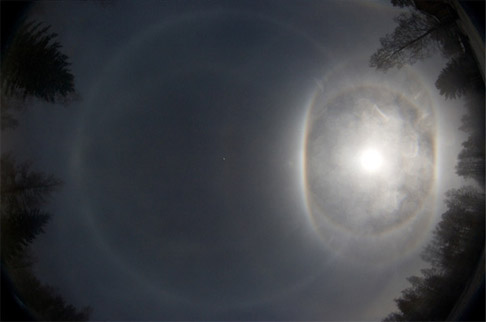
Arctowski's book of optical phenomena in the Antarctic
In 10 March 1897, a scientific research expedition ship Belgica got stuck in ice in the Antarctic waters. On board the ship was a Polish scientist Henryk Arctowski, who made notes of optical phenomena during the ship's one year and 3500 kilometer drift with the ice. His book of these observations, "Phenomenes Optiques de l'atmosphere", is now online ( 1 ).
Shown above is his most well known halo observation, the one with the "Arctowski arcs" that in the drawing rise from the horizon at about 120° from the sun. There are also other peculiarities, for Arctowski reports the patches of h to be 26 - not 22 - degree radius from the sun and the circumzenith arc distance from the zenith to be 28-29 degrees, which is probably more than it should be at the observation's sun elevation.
But if we leave the measurements aside and look at the drawing, the sunside of the sky looks pretty ordinary. The Arctowski arcs, which he writes as being faint, could be misplaced 46° infralateral arcs. And the rainbow in the opposite sky could be a fogbow. So, nothing extraordinary there, except maybe for the fogbow, that still has not been captured on film with halos in naturally lighted conditions.
Any French speaking readers here who could translate Arctowski's account of the display (PDF page 40-41)? It looks like he had made some interesting notes on the halos showing up in nearby crystals. I can add it here.
Shown above is his most well known halo observation, the one with the "Arctowski arcs" that in the drawing rise from the horizon at about 120° from the sun. There are also other peculiarities, for Arctowski reports the patches of h to be 26 - not 22 - degree radius from the sun and the circumzenith arc distance from the zenith to be 28-29 degrees, which is probably more than it should be at the observation's sun elevation.
But if we leave the measurements aside and look at the drawing, the sunside of the sky looks pretty ordinary. The Arctowski arcs, which he writes as being faint, could be misplaced 46° infralateral arcs. And the rainbow in the opposite sky could be a fogbow. So, nothing extraordinary there, except maybe for the fogbow, that still has not been captured on film with halos in naturally lighted conditions.
Any French speaking readers here who could translate Arctowski's account of the display (PDF page 40-41)? It looks like he had made some interesting notes on the halos showing up in nearby crystals. I can add it here.
Feliratkozás:
Megjegyzések (Atom)
